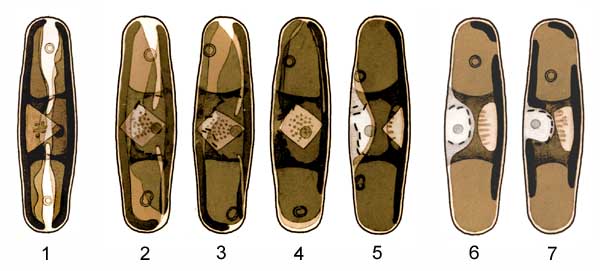Sellaphora capitata
1. Interphase cell, in valve view
This cell exhibits the same structure as we have shown photographically elsewhere. The chloroplast is H-shaped, consisting of two large plates, one on each side of the cell, connected by a narrow bridge (or isthmus). The bridge lies against the cente of the epivalve. A tetrahedral pyrenoid projects into the bridge from one side of the chloroplast. The nucleus (containing a single spherical nucleolus) lies in a bridge of cytoplasm (shown as a darker zone across the middle third of the cell) between two apical vacuoles. Each vacuole contains a spherical volutin granule, which generally lies in the apical plane of the cell.
2-5. Preparation for mitosis
Shortly before mitosis, the chloroplast moves across the cell so that its centre lies against the centre of the girdle; this involves a translational movement across a quarter of the cell periphery (Figs 2-4). The pyrenoid moves slightly further than the bulk of the chloroplast, since it ends up centred within the isthmus between the two chloroplast plates.
At the same time, the nucleus moves in the opposite direction, towards the side formerly occupied by the pyrenoid. It is often distended towards the centre of the girdle (Fig. 5), suggesting traction from this point. The two volutin granules move to characteristic positions along the midline of the girdle, on the same side of the nucleus.
During these rearrangements of the cell, the chloroplast changes in shape, developing a very wide invagination at the centre of each side (Fig. 5)
6, 7. Immediately after mitosis and cytokinesis (Figs 6 and 7 show only one of the two daughter cells)
Mitosis occurs while the nucleus is still immediately below the girdle, as shown in Fig. 5. Just before cytokinesis (described elsewhere) the chloroplast divides into two, so that each cell inherits a single plate of the parent chloroplast; this plate is asymmetrical and becomes even more so as the central invagination deepens and narrows (Figs 6, 7). The pyrenoid is usually much more rounded during mitosis and cytokinesis (Fig. 6) than at any other time in the cell cycle.
Each daughter cell inherits one of the two volutin granules present in the parent cell.


 This site is hosted by the Royal Botanic
Garden Edinburgh.
This site is hosted by the Royal Botanic
Garden Edinburgh.